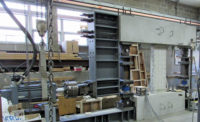Almost five years to the day after the February, 2011 earthquake that claimed 185 lives and destroyed much of the central business district in Christchurch, New Zealand, a magnitude-5.7 temblor tested the city’s rebuilt infrastructure.
“The [Feb. 14, 2016] earthquake was an unwelcome test of repairs to Christchurch’s damaged infrastructure, but [the repair work] stood up well,” says Ian Campbell, executive general manager of the Stronger Christchurch Infrastructure Rebuild Team (SCIRT).
SCIRT is in the final year of its five-year program to repair and rebuild roads, underground pipe networks, bridges and retaining walls damaged by the Christchurch earthquake. The New Zealand government has committed more than $13 billion to rebuilding the greater Christchurch area. But some economists predict it could take some $35 billion and up to 100 years for the country’s second-most-populous city to recover from infrastructure damage and costs incurred by private-sector stakeholders.
This year, SCIRT is on track to complete several months-long bridge repairs.
Engineers have been challenged to rehabilitate decades-old structures to comply with modern building codes. Noteworthy repairs include the Triumphal Arch, a war memorial standing on the Bridge of Remembrance. Campbell describes the project as “an extremely technically complex project.” The arch and the bridge have been strengthened to withstand a one-in-2,500-year earthquake event. “That reflects the heritage significance of the structures,” Campbell says.
Designers fashioned a solution that permits the arch to "rock" in an earthquake. Additional steelwork reinforces the arch foundations. Crews inserted heavy, manufactured steel boxes inside cavities within the two-arch limestone columns.
To avoid sending workers inside the structures, SCIRT used 3D modeling and laser-equipped survey teams to determine the exact proportions of the shafts inside the columns.
Post-quake subsidence left parts of Christchurch prone to flooding. Reconstruction has provided SCIRT an opportunity to repair wastewater and stormwater networks by employing various trenchless technologies, including pipelining, directional drilling and pipe bursting.
Extensive Earthquake Damage
In eastern Christchurch, where earthquake damage was extensive, the suburban towns of Aranui and Shirley are upgrading to new vacuum wastewater systems, which engineers say will provide greater resilience to future earthquakes than traditional gravity systems. Similarly, pressure wastewater systems are being installed in other suburbs where damage was severe and ground conditions are poor. Shallower installation depths offer easier and less expensive access and maintenance. The first 170 houses in Aranui were connected in early March to a state-of-the-art vacuum wastewater system.
The new wastewater system is a major portion of more than NZ$85 million ($58 million) in design and construction SCIRT is spending on new and rebuilt infrastructure in Aranui alone.
For efficiency and safety, SCIRT using a robot on one of the biggest projects—repairs to the Southern Relief, a wastewater trunk main running through densely populated parts of Christchurch.
The hydro-demolition robot "Geo" is providing faster and safer results for SCIRT repair contractor McConnell Dowell, which has a team working on the Southern Relief project in Linwood. "The thought of repairing underground pipe cracks with a handheld lance, in a confined space, is enough to make any health-and-safety officer concerned and a crew member’s blood pressure rise," says Stuart Anderson, McConnell Dowell’s project engineer.
McConnell Dowell and subcontractor Concrete Treatments NZ (CTNZ) are installing a 1.2-meter x 1.4-m box culvert that moves wastewater to the Bromley wastewater treatment plant from more than 200,000 suburban Christchurch households.
“Using the water pressure at the flow rate required to carry out the repairs, combined with the length of the lance, would pose a serious risk to the operator’s safety," Anderson says. "The solution was CTNZ’s purchase of the automated robotic hydro excavation tool. Geo has the ability to use the tool remotely, replacing handheld lancing. The robot’s compact nature allows it to enter and repair the box culvert safely and efficiently.
Anderson added, “Geo’s hydraulic and articulated arm can reach as far as three meters into horizontal, vertical and overhead areas, and its use has enabled a safer working environment for the crew. It means that crew members aren’t placed in an unsafe position to deal with flying concrete debris in a restricted space.”
Cofunded by the New Zealand government and the Christchurch City Council, SCIRT’s repair-and-renewal program is 87% complete. The bulk of the work is scheduled to wrap by December 2016. The Christchurch City Council will undertake less urgent repairs as part of its ongoing maintenance program.
So far, crews have repaired or replaced some 533 kilometers of wastewater pipe—78% of the network's design scope—along with 63 pumping stations (82%). Some 56 km of stormwater pipework (63%) is finished, and 91 km of fresh (potable) water pipeline (72%) has been replaced.
Liquefaction during the earthquake left the city's roads in need of extensive repair and renewal. To date, crews have repaved almost 1.4 million sq m of road (83%), 140 bridges and culverts (97%) replaced, and 142 retaining walls either repaired or replaced.





Post a comment to this article
Report Abusive Comment